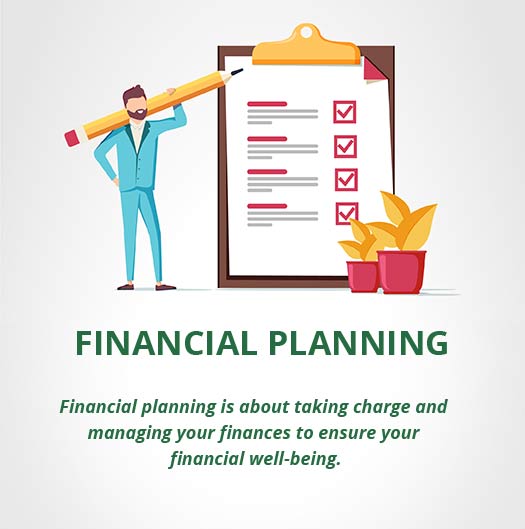No products in the cart.
Financial planning is about taking charge and managing your finances to ensure your financial well-being.
It may be helpful to view financial planning as comprising six different areas:
- Managing your cashflow for your needs today and also to meet future goals like your retirement or your children's education;
- Managing you and your family's exposure to unforeseen events like pre-mature death, illness or disability;
- Investment planning to meet your financial goals;
- Planning for your retirement;
- Planning your taxes efficiently; and
- Planning the transfer of your estate to the people and causes you care about

Financial planning involves three key steps:
Identifying your immediate (short term) and longer term needs (like getting health insurance; paying for your household expenses) and goals (like saving for a home or for your retirement)
Identifying your immediate (short term) and longer term needs (like getting health insurance; paying for your household expenses) and goals (like saving for a home or for your retirement)
Managing the resources, e.g. using a budget and having a plan for your savings and investments to help you reach your goals. There is a range of financial products to choose from to help you with your needs and goals. Choose something suitable for you.
Get started or update your financial plan today by reviewing the three steps:

Setting Goals

Assessing your financial situation

Managing your resources Budgeting
Setting Goals
The first step is to know what you are planning for. Make a list of all your needs and goals. Managing day-to-day living expenses comes first.
Other needs and goals could be:
- Being debt-free
- Having emergency reserves (say 3-6 months of all expenses)
- Having health insurance
- Meeting retirement needs
- Buying a home
- Financial protection against unexpected events such as the death of family breadwinner(s), critical illness or permanent disability
- Paying for your children's education
Work out how much you need for each goal or need. For some, it could be an amount that you need to pay regularly, e.g. home loan instalments, health and life insurance premiums. For goals like retirement savings, it could be a lump sum amount at your desired retirement age. If it’s paying for your children’s tertiary education, you might find that a combination of savings and loans works best for you. When projecting future values, take into account current prices and projected inflation.
Next, look at how much you have to start with by assessing your financial situation.

Assessing your financial situation
List out all the resources you have, such as your salary and wages, any bank savings or investments like shares or unit trusts. If you have any insurance products which are bundled with investments or savings, like whole life participating policies, investment linked plans or endowment plans, do list out how much protection you are getting and the value of the investments portion (do note that the projected values in your benefit illustration are not guaranteed).
Also make a list of all your liabilities or outgoings – there are household expenses to pay, debts you owe (e.g. home loans, car loan payments), credit card balances, health and life insurance premiums, taxes and so on.
Next, look at how you can manage them to pay for those needs and goals.

Managing your resources Budgeting
Use a budget to help you manage your income, spending, debt and other liabilities prudently. The aim is to take care of your basic living expenses as well as put aside amounts for savings and investments to meet your other goals.
If you have an existing budget, review it from time to time to make sure it still works. If you are new to budgeting, look up the MoneySENSE budget calculator to help you get started and read these tips:
- Include income that you can count on (e.g. basic wage or salary) for your budget. Do not include as income any money you are not sure you will earn (e.g. bonuses & commissions). If you are not sure you are going to receive this, do not count on it for spending or to repay debt.
- Include all expenses such as taxes, debts (e.g. loan or credit card payments and retail instalment plans) transportation, utilities, food and necessities. If you are supporting your elderly parents, include any contribution or financial help you give them. Also include expenses for the occasional shopping and outings. Add in the amounts you currently spend on insurance, or that you set aside for investments and savings.
- Monitor your budget regularly to see if you are on track. Adjust your budget if, for example, you get a pay rise or suffer a pay cut or if you have another addition to the family.
- If you have a surplus, think about how you can use this money prudently - say, to pay off a debt provided there is no or little penalty, or add this to your savings. If you have a deficit, you will need to see where you can cut expenses.
| Where did my money go? |
| You can’t cut down on some expenses, for example, your taxes, conservancy charges and utilities bills. Once you have incurred a debt or committed to an insurance policy, you will need to keep up with repayments or insurance premiums. So think hard about what you really need and can afford before you commit to either of these. Remember you should avoid taking on excessive debt. As a guide, try to limit your debt ratio to 35% of your monthly income. In the case of life insurance, consider getting basic life insurance like term insurance if you want to keep insurance premiums manageable. |
| On the other hand, you might be able to reduce some basic living expenses, e.g. you could change to house brands when shopping for food or basic household items. You can also reduce discretionary spending like on clothes you don’t really need or going out for a meal. |
| It is important to be able to distinguish Needs from Wants. Needs are goods and services you require in your life. Wants are those things you desire – they could also be more expensive (but not necessarily better) substitutes for your needs or just non-essential. |
| Planning your savings and investments to help you reach your goals |
| Here are some tips to help you put your plan together: |
- Prioritise your goals. For many, having emergency savings and some health insurance and life insurance protection will come first. Saving and investing for your retirement will probably come next.
- If you haven't already done this in Step 1, work out the cost of each goal and how much time you have to save or invest before you need to pay for it (this is called the investment time horizon). For example, you might need Rs. 10,00,000 for a wedding in two years' time or Rs. 25,00,000 for your child's education in 15 years' time. If you are making projections about future values, you will need to take into account current prices as well as projected inflation.
- For insurance, work out your healthcare needs as well as how much life insurance coverage you want for your dependants. Many insurance products bundle protection coverage and investments or savings together. When buying life insurance, make sure you are clear about what you want for the protection of your family and whether you want the product to provide investment returns too. You do not need to buy a bundled insurance and investment product if you only require protection for your family. If your resources are limited, make sure you get some basic coverage first. You can always increase coverage later when you are better able to afford this.
- Work out how much resources you now have and how much more you will need for your goals. You might have Rs.1, 00,000 in savings today but want to save Rs. 30, 00,000 for retirement in 30 years' time.
- Identify suitable action steps to help you close the shortfall and reach your goal. To build up emergency savings of 6 months' salary, you might need to save $1,000 per month for the next 18 months. You might need to put aside more in savings or investments to achieve this. By starting earlier, your savings will benefit from the power of compounding and have more time to grow. If you are investing, i.e. buying financial products for investment, a longer time frame allows you more time to ride out any short-term fluctuations.
- Limit borrowing to only when it is really necessary, for example to buy a home.
- Do consider the range of financial products and investments available to you. You will need to spend some time understanding them and how to use them to reach your goals. There are also some products which claim to help you reach a specific goal, like an endowment plan for your children's education. But all investments carry risk (for example, they may not achieve the desired returns or you may lose money), so always remember to buy only the products you fully understand and have a level of risk you are comfortable with. If you already have adequate life insurance protection, you should not consider buying bundled insurance-investment products to meet your savings or investment needs.
- To reduce risk, you should as far as possible, maintain a diversified portfolio of investments. When choosing a particular product for investing, find out whether it will complement the products you already have or expose you to more risk (you could already be heavily invested in one type of asset class, e.g. shares, or overly exposed to a particular market, e.g. the IT industry)
- Remember to include in your budget the amounts you are investing or saving regularly.
- Monitor your investment portfolio regularly: review the current and projected values and see if their growth is on track to meet your requirements. You may need to rebalance your investments from time to time to ensure diversification of your investments. If you are nearing the time you need the money, you may want to move your investments into more conservative assets to preserve their value.
- Keep track of factors that affect our plans, e.g. changes to government policies on home loans and the CPF Investment Scheme, inflation, and if there is an increase in the projected costs for certain goals.
- Review your financial plan regularly and adjust it when your resources, needs and situations change.
- Be prepared to save more, cut back expenses, or even reprioritise your goals.
A financial plan should grow and adjust depending on the life stage you are at. Generally, the earlier you take action, the more time you have for your savings and investments to grow.
